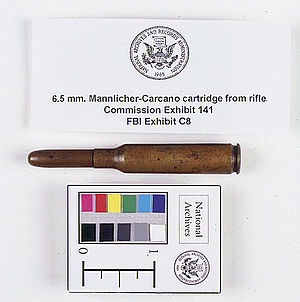- 6.5×52mm Mannlicher-Carcano
-
6.5×52mm Mannlicher-Carcano 
Type Rifle Place of origin  Kingdom of Italy
Kingdom of ItalyService history In service 1891–1970 Used by Italy, Finland, Nazi Germany Wars First Italo-Ethiopian War, Italo-Turkish War, World War I, Second Italo-Abyssinian War, Spanish Civil War, World War II Production history Designed 1889–1891 Produced 1891–Present Specifications Case type Rimless, bottleneck Bullet diameter 6.80 mm (0.268 in) Neck diameter 7.52 mm (0.296 in) Shoulder diameter 10.85 mm (0.427 in) Base diameter 11.42 mm (0.450 in) Rim diameter 11.42 mm (0.450 in) Case length 52.5 mm (2.07 in) Ballistic performance Bullet weight/type Velocity Energy 10.5 g (162 gr) RN 700 m/s (2,300 ft/s) 2,572 J (1,897 ft·lbf) 10.5 g (162 gr) RN 661 m/s (2,170 ft/s) 2,293 J (1,691 ft·lbf) Test barrel length: above 780 mm; below 445 mm. 6.5×52mm Carcano or 6.5×52mm Mannlicher-Carcano is an Italian military 6.8 mm (.268 cal, actually 0.2675 inches) rimless bottle-necked rifle cartridge, developed from 1889 to 1891 and used in the Carcano 1891 rifle and many of its successors. A common synonym in US gun literature is "6.5mm Italian". In US parlance, "Carcano" is frequently added to better distinguish it from the rimmed hunting cartridge 6.5×52mmR (US version: .25-35 Winchester). Ballistically, its performance is very similar to that of the 6.5×54mm Mannlicher-Schönauer.
Contents
Design
Under the direction of the "Commissione delle Armi Portatili" (Commission for Portable Weapons), instituted in 1888 to develop a smokeless-powder rifle for the Italian Army, the "Reale Laboratorio Pirotecnico di Bologna" (Royal Pyrotechnical Laboratory of Bologna) developed and tried several different cartridge designs, with a bullet diameter from 8 mm to 6 mm. Finally, due also to the influence of Major Antonio Benedetti, of the Brescia Arsenal, Secretary of the Commission and strong supporter of the advantages of smallbore cartridges, the 6.5×52 cartridge was adopted in March 1890, prior to the adoption of the rifle that used it (the Model 1891 Carcano rifle).
After the adoption of the cartridge, the arsenals technicians worried about the characteristics of the original ballistite load, since that propellant was considered too erosive (flame temperature of 3000-3500 °C) and not stable under severe climatic conditions. Several other loads were tested, including the British cordite but without good results, until the Reale Polverificio del Liri (Royal Explosives Factory of Liri) developed a new propellant called "Solenite", composed of trinitrocellulose (40%), dinitrocellulose (21%), nitroglycerine (36%), mineral oil (3%), and shaped in large tube-like grains. The new propellant, that reduced the flame temperature to 2600 °C and proved to be very stable, was adopted in 1896 and never changed until the end of the military production of the cartridge.
The 6.5×52mm Carcano was designed as a full-blown infantry cartridge. In accordance with the tactics of the time, the adjustable rear sight of the rifle allowing for volley fire up to 2,000 metres. The 6.5×52mm Carcano was the first to be officially adopted of a class of similar smallbore military rifle cartridges which included the 6.5×50 Arisaka (Japan), 6.5×53R Mannlicher (Romania / Netherlands), 6.5×54 Mannlicher-Schönauer the (Netherlands), 6.5×55 Swedish Mauser (also Norwegian Krag-Jørgensen), 6.5×58 Portuguese.
A comparison with larger bore smokeless powder cartridges of the 7.62mm and 8mm calibre class (which class started in 1886 with the French 8×50R Lebel, continuing with the German 7.92×57, the Austrian 8×50R, the British .303, the Russian 7.62×54R, the Belgian and Argentine 7.65×53, the .30-40 Krag, and the much later .30-03 and .30-06) may make the 6.5mm rounds appear "underpowered" on paper though[citation needed], and lacking in stopping power. On the other hand, the small bore cartridges seem to have a long list of advantages, as flatness of trajectory, outstanding penetration at distance, less weight, less recoil, smaller dimensions, and less material required in production.
Its short-lived intended successor cartridge, the 7.35×51mm Carcano, is sometimes identified as the first intermediate round, before the German 7.92×33 and the Soviet 7.62×39.
The original 6.5×52mm barrel design, developed by the Brescia Arsenal at the same time as the cartridge before development of the M91 Carcano Rifle itself, used a gain twist barrel with deep rifling to reduce wear, extend barrel life and give consistent accuracy. Gain twist has a slow initial twist in the barrel progressively getting faster until the final twist rate is attained near the muzzle, resulting in less torque being imparted to the bullet during the highest stress phase of the interior ballistic cycle, and thus less barrel wear in the throat of the barrel. (Gain twist was phased out in the last production of the Carcano rifle in favour of conventional rifling.)
Performance
The 6.5×52 Carcano is an effective deer cartridge up to 200 m (220 yards), with properly-bulleted ammunition. Its main drawback in military use was that the standard Italian service round had a round-nosed bullet and was highly stable (did not usually tumble unless it hit bone), giving many narrow-channel straight-through wounds.[citation needed] This characteristic is due to the high sectional density of the round (the extreme bullet length compared to its diameter).
Hand loaders should note that the currently available factory ammunition may lack accuracy due to use of a 6.7 mm (.264 in) bullet instead of the 6.8 (.268 in) as originally loaded.[citation needed]
Notable uses
Main article: John F. Kennedy assassination rifleThe cartridge has achieved some notoriety, as a World War II Italian Carcano rifle was identified by the Warren Commission as the weapon used by the assassin of President John F. Kennedy, former Marine Lee Harvey Oswald.
See also
References
- 6.5×52mm Carcano cartridge dimensions
- www.il91.it
- G.Simone, R. Belogi, A. Grimaldi, "Il 91", Ravizza (1970)
External links
Categories:- Pistol and rifle cartridges
- Military cartridges
Wikimedia Foundation. 2010.

